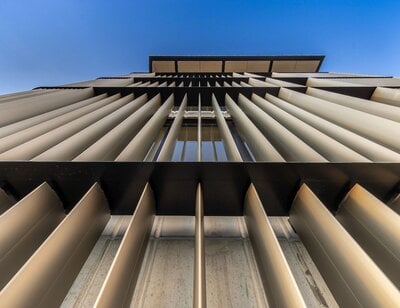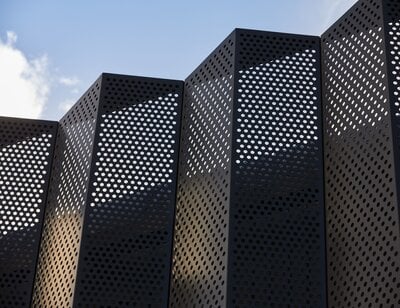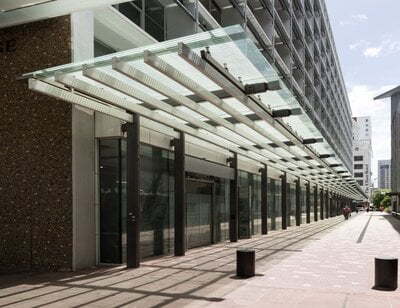New Zealand has over 2,500 schools. Governed by a complex set of rules and regulations, all have their own challenges, many unique to their own immediate environment and community. Yet all will have to deal with the issues of sun control. Whilst the importance of doing so may seem somewhat trivial at first glance, the assumption being based upon improved occupant comfort levels alone, the benefits actually extend all the way through to improved academic success.
- Glare
- Excess Heat Build-Up
- Academic Research & Ministry of Education Advice
- Aesthetics
Glare:
Today's classrooms are somewhat different to what many of us will remember. The unstoppable march of all things digital has firmly made it into education, with many students now expected to bring their own devices to assist with curriculum based learning. This raises an issue the classrooms were likely not designed to cope with, namely glare. Tablet and laptop screens are generally very reflective and the resultant glare from the screens are known to cause a myriad of issues. These include eye strain, fatigue, headaches, blurred vision and dry eyes ( the feeling you have something in your eye). Part of the issue is not just the presence of glare but the difference when shifting visual focus in and our of glare (or light to shadow_. This will cause the eyes and its supporting muscles to work harder, hence possible eye strain and fatigue. Furthermore, research has suggested that even moderate glare has a negative effect on concentration and reading. For teachers, one can only assume any negative impact on concentration levels is any unwelcome guest in the classroom.
It may not be just the electronic devices causing an issue either, Modern, interactive whiteboards (even old fashioned whiteboards for that matter) will produce some glare. This will give rise to the same issues as detailed above.
Remove all the devices and the direct sunlight will usually continue to be a pain. Trying to concentrate your attention when someone is shining a torch in your eye is far from ideal. In short, the direct sunlight from a high midday sun is troublesome whenever concentration and learning is called for, which is undoubtedly in the classroom.
Excessive Heat Build-Up:
At the same time as the sun makes it presence felt visually, it will do so atmospherically. Unobstructed, direct sunlight can heat a room to an uncomfortable degree. Some schools have blinds but these are only really of use for issues of glare. By the time the sun has reached the blind, the heat is already inside the building.
It's here the oft referenced 'Hierarchy of Needs' by Abraham Maslow comes into play. It tells us that when the temperature is too hot or too cold, we fail to meet higher level needs such as self-actualisation and learning. In short, we become irritable, fidget and look for ways to address our thermal discomfort. This does nothing for our attention span and we'll confidently predict it only takes one irritable child to disrupt a classroom.
There's an abundance of scientific evidence to support the need for sun control and excessive heat build-up. The National Bureau of Economic Research at Harvard, studied PSAT scores for a 13 year period up until 2014. With a sample of over 10 million students over the prolonged research period, the conclusions are irrefutable. It found that, on average, a school year that was hotter by 1℉ (0.56℃) correlated to a loss of 1% of the years learnings. The result to take away from this is clear, cumulative heat exposure inhibits cognitive skills development.
Academic Research & Ministry of Education Advice:
In 2015, the University of Salford (Mancehster) released what is widely considered to be the leading study on classroom design, entitled 'Clever Classrooms’. It is certainly heavily used and borrowed by the New Zealand Ministry of Education.
The study found that 'differences in the physical characteristics of classrooms explain 16% of the variation in learning progress over a year'. To illustrate the point, the study notes it is estimated the impact of moving a child from the least effective space to the most effective space would be around 1.3 sub-levels. This is significant impact given a student is expected to progress by 2 sub-levels per year.
No single factor is pinpointed as the culprit behind the deterioration of the learning experience where classroom design is sub-optimal. That said, when combined the factors within the category termed as 'naturalness' make up 49% of the change. Within the category there are light (21%), temperature (12%) and air quality (16%). Referring back to the issues of glare and excessive heat build-up, it is both possible and logical to draw a line between the benefit of louvres in improving an area of classroom design that is responsible for 33% of the physical learning environment based issues.
Going further, it is entirely plausible to suggest a benefit for air quality may also be derived from louvres, as you can open the window and allow air to circulate without letting in either glare or heat. Or incurring the rattling of blinds (and their acoustic distraction).
The Ministry of Education set forth specific guidelines for New Zealand schools in ‘Designing Indoor Quality Learning Spaces: Indoor Air Quality and Thermal Comfort’ (September 2017). With the Ministry holding one of the largest property portfolios in New Zealand, comprising over 2000 schools and in excess of 30,000 buildings, the paper sets forth minimum expectations and, as previously mentioned, borrows heavily from the fundings in the University of Salford study. This includes the use of sun-shading from louvres to combat both glare and overheating.
It is worth noting the discussion in the paper regarding cost, which is not unexpected given the budgetary complexity of the education system. This is further expanded upon within the recent Ministry of Education ‘School Property Strategy 2030’ where it forms a core component of the strategy. This should come as no surprise and is expected, as are references to sustainability and passive design principles. It is here that louvres will also be of benefit. There is little in the way of ongoing costs and by reducing excessive heat build up, they reduce the burden on energy use through HVAC systems.
Aesthetics:
Aside from both the functional and environmental benefits of louvres in school design for solar control, they can also add a design aesthetic which bring with it a touch of personalisation for the school. For example, the use of either anodised aluminium or a powder coated finish, to match the school colours, is effective in creating a sense of belonging and reinforcing the presence of the school visually. It wouldn't be too far-fetched to suggest there is something akin to enclothed cognition in clothing., whereby (for example) when you wear the colours of a particular team it can help increase performance.
Of course, the use of colour is only part of the possible aesthetic advantages, the design and placement of the louvre blades themselves able to visually improve an education space.
Other Benefits:
Whilst we have largely concerned ourselves with solar control, it would be remiss not to mention other advantages of louvres which may not be immediately apparent. For example, where a classroom is used to intermittently, louvres will provide on-going benefit and negate the possible need of having to prepare the room for students bu either opening the window or turning on the air conditioning in order to deal with any excessive heat build-up ahead of the students arriving for their lesson.
A similar benefit is evident in comparison with blinds, which have to be 'operated'. Blinds are also subject to accidental or willful damage, and the cords (or chains) used to operate some blinds may pose a safety risk in some classrooms.
In conclusion, school design comes with a unique set of requirements and responsibility. The issue of solar control is just one problem from a complex set which needs to be solved if we are to provide the best possible education infrastructure for our young. With the solution widely available, it is one which can be ticked off with relative ease. Class over.








